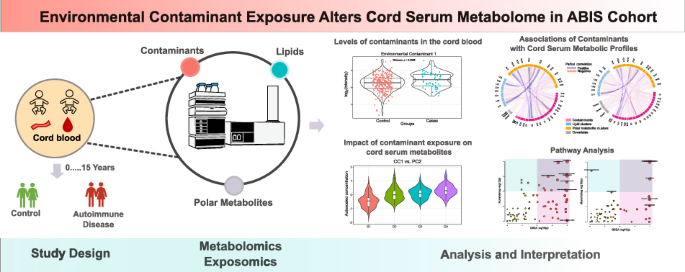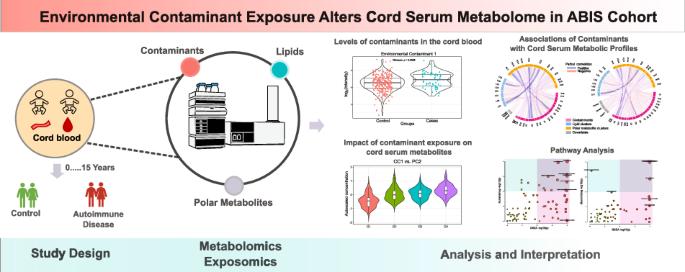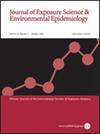Prenatal exposure to environmental contaminants and cord serum metabolite profiles in future immune-mediated diseases
IF 4.1
3区 医学
Q2 ENVIRONMENTAL SCIENCES
Journal of Exposure Science and Environmental Epidemiology
Pub Date : 2024-04-27
DOI:10.1038/s41370-024-00680-z
引用次数: 0
Abstract
Prenatal exposure to environmental contaminants is a significant health concern because it has the potential to interfere with host metabolism, leading to adverse health effects in early childhood and later in life. Growing evidence suggests that genetic and environmental factors, as well as their interactions, play a significant role in the development of autoimmune diseases. In this study, we hypothesized that prenatal exposure to environmental contaminants impacts cord serum metabolome and contributes to the development of autoimmune diseases. We selected cord serum samples from All Babies in Southeast Sweden (ABIS) general population cohort, from infants who later developed one or more autoimmune-mediated and inflammatory diseases: celiac disease (CD), Crohn’s disease (IBD), hypothyroidism (HT), juvenile idiopathic arthritis (JIA), and type 1 diabetes (T1D) (all cases, N = 62), along with matched controls (N = 268). Using integrated exposomics and metabolomics mass spectrometry (MS) based platforms, we determined the levels of environmental contaminants and metabolites. Differences in exposure levels were found between the controls and those who later developed various diseases. High contaminant exposure levels were associated with changes in metabolome, including amino acids and free fatty acids. Specifically, we identified marked associations between metabolite profiles and exposure levels of deoxynivalenol (DON), bisphenol S (BPS), and specific per- and polyfluorinated substances (PFAS). Abnormal metabolism is a common feature preceding several autoimmune and inflammatory diseases. However, few studies compared common and specific metabolic patterns preceding these diseases. Here we hypothesized that exposure to environmental contaminants impacts cord serum metabolome, which may contribute to the development of autoimmune diseases. We found differences in exposure levels between the controls and those who later developed various diseases, and importantly, on the metabolic changes associated with the exposures. High contaminant exposure levels were associated with specific changes in metabolome. Our study suggests that prenatal exposure to specific environmental contaminants alters the cord serum metabolomes, which, in turn, might increase the risk of various immune-mediated diseases.


产前接触环境污染物与未来免疫介导疾病的脐带血清代谢物特征
背景产前暴露于环境污染物是一个重大的健康问题,因为它有可能干扰宿主的新陈代谢,从而导致幼儿期和日后对健康产生不良影响。越来越多的证据表明,遗传和环境因素以及它们之间的相互作用在自身免疫性疾病的发展中起着重要作用。方法我们从瑞典东南部所有婴儿(All Babies in Southeast Sweden,ABIS)普通人群队列中选取了脐带血清样本,这些样本来自后来患上一种或多种自身免疫介导的炎症性疾病的婴儿:乳糜泻(CD)、克罗恩病(IBD)、甲状腺功能减退症(HT)、幼年特发性关节炎(JIA)和 1 型糖尿病(T1D)(所有病例,N = 62),以及匹配的对照组(N = 268)。我们利用基于暴露组学和代谢组学质谱(MS)的综合平台,测定了环境污染物和代谢物的水平。污染物暴露水平高与代谢组(包括氨基酸和游离脂肪酸)的变化有关。具体而言,我们发现代谢物特征与脱氧雪腐镰刀菌烯醇(DON)、双酚 S(BPS)以及特定全氟和多氟化合物(PFAS)的暴露水平之间存在明显关联。然而,很少有研究对这些疾病发生前的常见和特殊代谢模式进行比较。在此,我们假设暴露于环境污染物会影响脐带血清代谢组,这可能会导致自身免疫性疾病的发生。我们发现,对照组与后来患上各种疾病的对照组之间在暴露水平上存在差异,重要的是,与暴露相关的代谢变化也存在差异。污染物暴露水平高与代谢组的特定变化有关。我们的研究表明,产前暴露于特定环境污染物会改变脐带血清代谢组,进而可能增加各种免疫介导疾病的风险。
本文章由计算机程序翻译,如有差异,请以英文原文为准。
求助全文
约1分钟内获得全文
求助全文
来源期刊
CiteScore
8.90
自引率
6.70%
发文量
93
审稿时长
3 months
期刊介绍:
Journal of Exposure Science and Environmental Epidemiology (JESEE) aims to be the premier and authoritative source of information on advances in exposure science for professionals in a wide range of environmental and public health disciplines.
JESEE publishes original peer-reviewed research presenting significant advances in exposure science and exposure analysis, including development and application of the latest technologies for measuring exposures, and innovative computational approaches for translating novel data streams to characterize and predict exposures. The types of papers published in the research section of JESEE are original research articles, translation studies, and correspondence. Reported results should further understanding of the relationship between environmental exposure and human health, describe evaluated novel exposure science tools, or demonstrate potential of exposure science to enable decisions and actions that promote and protect human health.

 求助内容:
求助内容: 应助结果提醒方式:
应助结果提醒方式:


